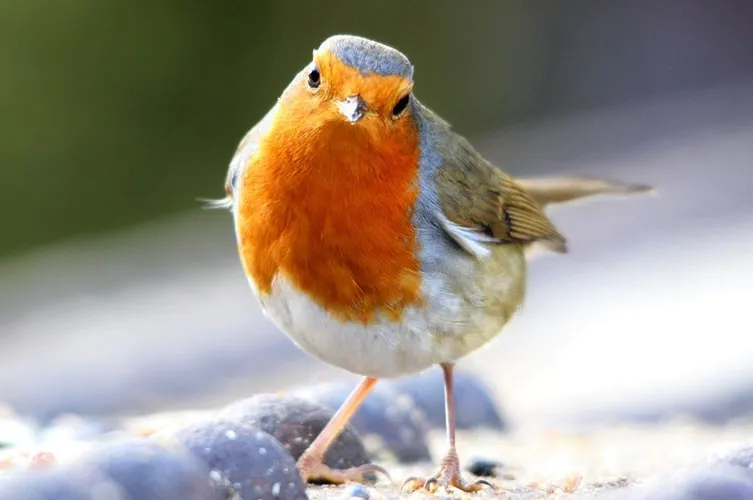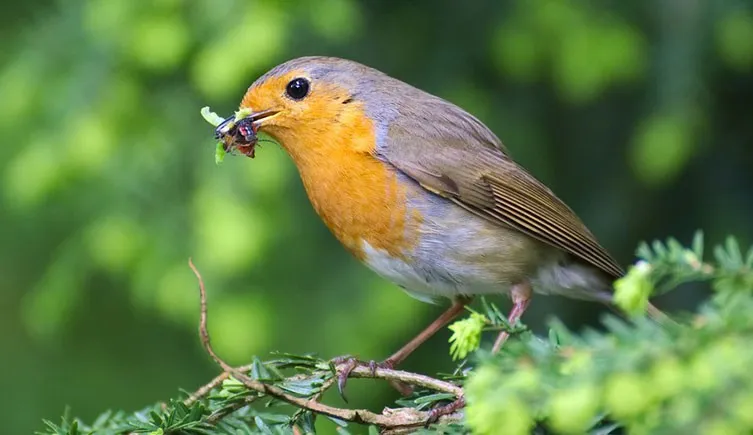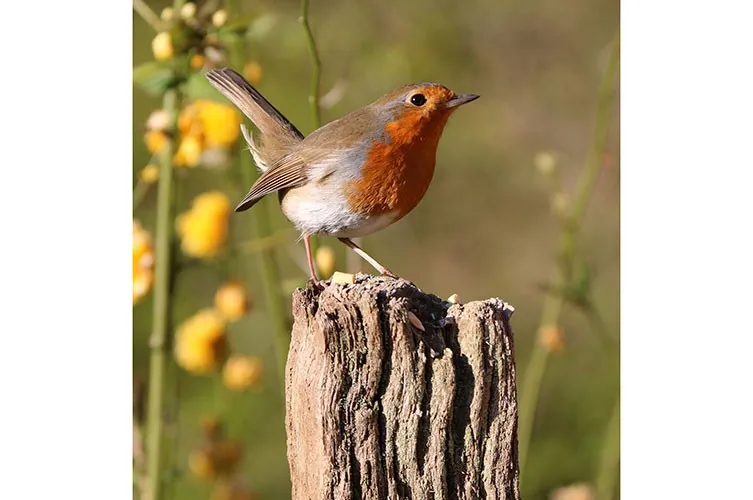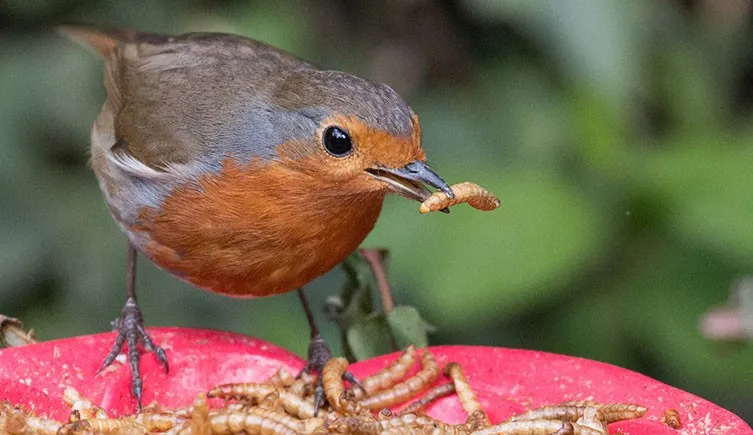The European robin (Erithacus rubecula), often perceived as a charming and gentle bird, possesses a surprisingly fierce and territorial nature. This beloved British garden resident, easily recognizable by its vibrant red breast, is a subject of fascination for many. As the UK robin population continues to grow, understanding their behaviours becomes increasingly important for enthusiasts and conservationists alike. This article delves into the intricate world of Robin Bird Behaviour, exploring their territorial defense, social interactions, breeding habits, and more, providing a comprehensive guide for those interested in these captivating birds.
Identifying the Robin: Appearance and Lifespan
Robins are small, plump birds measuring approximately 14cm in length with a wingspan of 20-22cm, weighing between 14-21g. Both male and female robins share identical plumage: a brown back, a white belly, and a distinctive red breast, face, and cheeks. Juvenile robins, however, are born with speckled gold and brown feathers, gradually developing the iconic red coloration as they mature into adulthood. The average lifespan of a robin is around two years. The UK robin population is robust, with an estimated 6,700,000 territories, and they are classified as ‘least concern’ on the IUCN Red List and protected under the green list in the UK.
 An adult European robin with its distinctive red breast and face, looking alert.*An adult robin. Males and females have the same colouring.*
An adult European robin with its distinctive red breast and face, looking alert.*An adult robin. Males and females have the same colouring.*
Diet and Feeding Habits of Robins
The diet of a robin is varied, encompassing seeds, fruits, insects, worms, and other invertebrates. They are also known to frequent garden bird tables, readily feeding on scraps and mealworms. Robins often exhibit a remarkable lack of fear towards humans, frequently following gardeners to take advantage of freshly dug-up worms. Some have even been observed to feed directly from people’s hands, showcasing a unique interspecies interaction.
 A robin holding a small invertebrate in its beak, ready to eat.*This robin is about to feast on a variety of invertebrates.*
A robin holding a small invertebrate in its beak, ready to eat.*This robin is about to feast on a variety of invertebrates.*
Robin Habitat and Distribution
Robins are widespread throughout the United Kingdom, thriving in diverse environments. They can be found in farmland and woodland, as well as in the gardens and parks of both towns and cities. Their adaptability allows them to coexist with human populations, making them a common sight for many.
Robin Behaviour: Territoriality and Social Dynamics
A key aspect of robin bird behaviour is their highly territorial nature. Both male and female robins maintain distinct territories. During the summer breeding season, these territories are held jointly as a pair, while in winter, they are defended individually. This defense is surprisingly ferocious, involving aggressive driving off of intruders and loud singing from prominent perches to announce their presence and boundaries.
 A juvenile robin with speckled brown and gold feathers, lacking the red breast.*Young European robins lack the distinctive red breasts of adult male and female robins.*
A juvenile robin with speckled brown and gold feathers, lacking the red breast.*Young European robins lack the distinctive red breasts of adult male and female robins.*
Breeding and Nesting Practices
The breeding season for robins typically commences in March, though courtship can begin as early as January during mild weather. During the courtship period, the male robin shares a significant portion of his food with the female, providing over a third of her nutritional needs. The female constructs a cup-shaped nest, low to the ground, using materials such as dead leaves, moss, and hair. These nests are often concealed in tree roots, dense shrubs, or climbers like ivy. Unconventional nesting sites, such as old wellington boots or plant pots, have also been observed.
Robins are particularly sensitive to disturbances during the nest-building and egg-laying phases and may abandon their nests if they perceive a threat. The female usually lays four to six eggs, which she incubates for approximately 13 days. Upon hatching, the female promptly removes the eggshells from the nest. Both parents are dedicated to caring for the nestlings, providing them with food and warmth. The chicks fledge after about 14 days but remain dependent on their parents, primarily the male, for another three weeks. Robins typically raise at least two broods per year, with nestlings present as late as the end of July.
 A robin perched on a wooden post, tail slightly raised, surveying its surroundings.*A robin perched on a post watching over its territory, which it will defend aggressively.*
A robin perched on a wooden post, tail slightly raised, surveying its surroundings.*A robin perched on a post watching over its territory, which it will defend aggressively.*
 A robin carrying a clump of moss in its beak, likely for nest building.*A robin gathering moss for its nest.*
A robin carrying a clump of moss in its beak, likely for nest building.*A robin gathering moss for its nest.*
How to Spot and Attract Robins
Robins can be observed year-round in various habitats, including gardens, parks, and hedgerows, across both rural and urban landscapes. To spot a robin, look for its unmistakable bright red breast and listen for its melodious song. Robins are unique among birds for singing throughout the year, with a brief pause only during midsummer when they moult. They are among the earliest birds to begin singing in the dawn chorus and the last to cease their song in the evening.
Robins are naturally ground feeders, making feeding trays an effective way to encourage them into your garden. They are also known to scavenge for scraps that fall from hanging feeders. Mealworms are a particular favourite, though they also show a preference for sunflower hearts.
 A robin feeding on a tray filled with mealworms.*Mealworms are a favourite food of robins. Feeding these birds during winter can help them survive cold conditions.*
A robin feeding on a tray filled with mealworms.*Mealworms are a favourite food of robins. Feeding these birds during winter can help them survive cold conditions.*
Conservation Status and Threats to Robins
The UK robin population has seen a significant increase of 45% since the 1970s and continues to grow. However, the most substantial threat to robins is prolonged, severe winter weather. During cold nights, robins expend a considerable amount of energy, up to 10% of their body weight, to maintain their body temperature. Failure to replenish these vital fat reserves can prove fatal. Providing supplementary food on bird tables during harsh winter conditions can greatly improve their chances of survival.
Did You Know?
The robin’s association with Christmas began in the Victorian era. Postmen, identifiable by their red waistcoats, were nicknamed ‘robins’. This led to robins appearing on Christmas cards as a symbol representing these delivery personnel.
